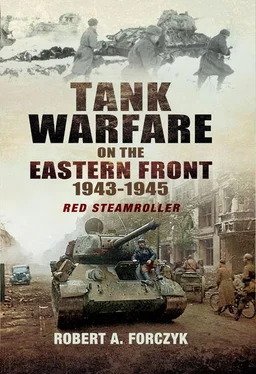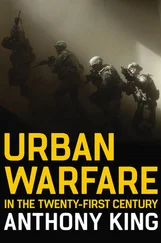Another important structural change that the Red Army instituted during the lull was the reorganization of their tank armies into homogenous formations by excluding non-motorized elements. Heretofore, Soviet tank armies in 1942 had often included rifle divisions that could not keep up with armour in the attack. The first of the new-style tank armies was the 5th Guards Tank Army (5 GTA), established in late February 1943. {82} The Stavka’s intent was to build the tank armies up into powerful manoeuvre formations, designed to exploit the operational success achieved by front-level forces.
The Stavka decided to employ an unprecedented amount of armour for the Kursk operation, including all five tank armies (which possessed a total of 3,474 tanks in 12 tank and four mechanized corps). In addition, six other independent tank corps were assigned as Front-level tactical reserves, two for Rokossovsky’s Central Front and four for Vatutin’s Voronezh Front. Each of the field armies defending the Kursk salient was also assigned tank brigades and tank regiments for direct infantry support, totalling eight tank brigades and 22 separate tank regiments. Trainloads of tanks were poured into the Kursk salient in April-June, refilling the depleted ranks of front-line tank units. In addition, seven self-propelled artillery regiments (SAP) were shipped into the Kursk salient, including three with the new SU-152 self-propelled guns. By July, Rokossovsky’s Central Front had a total of 1,451 tanks and 115 self-propelled guns, including 447 in Rodin’s 2TA. Vatutin’s Voronezh Front had 1,613 tanks and 54 self-propelled guns, including 587 in Katukov’s 1TA (see Table 3). Altogether, the two Soviet fronts that would have to defend against Zitadelle had 3,064 tanks and 158 self-propelled guns. This armour included 728 light tanks (23 per cent of the total) and 375 Lend-Lease tanks (12 per cent). However, this type of aggregation – which is used in many histories of the Battle of Kursk – is deceptive, since three of the 10 Soviet combined-arms armies in the Kursk salient (38, 60 and 65) were not actively involved in the battle and three others (40, 48, 70) were only partially engaged in the defensive phase; this means that at least 15 per cent of the deployed Soviet armour was not engaged during the defensive phase. Surprisingly, Vatutin and Rokossovsky left 329 tanks facing the 2.Armee on the face of the Kursk salient, even though this formation was not participating in Zitadelle and had only a single Sturmgeschütz-Abteilung in support. This deployment indicates that the Soviet Front commanders did not employ ‘economy of force’ with their armour assets as their German opposite numbers did.
Finally, the RVGK began assembling an operational reserve east of Kursk to spearhead the anticipated counter-offensive; this reserve initially consisted of General-leytenant Pavel A. Rotmistrov’s 5th Guards Tank Army (5GTA), the 5th Guards Army (5GA) and 5th Air Army, but more formations were added once Zitadelle began. Rotmistrov was considered one of the Red Army’s best senior-level armour leaders and he was given five corps and over 800 tanks; this formation was expected to achieve decisive results when committed. The Stavka kept 5GTA and 5GA under its control until the Battle of Kursk began, then established the Steppe Front under General-polkovnik Ivan Konev to command them.
Table 3: Allocation of Soviet armour for Kursk Defensive Operation.

During the defence, Rokossovsky and Vatutin would also employ 169 self-propelled guns (SPGs), including 36 SU-152, 71 SU-122, 29 SU-76 and 33 SU-76i. The limited number of SU-76s deployed at Kursk and the inclusion of the Su-76i built on captured German Pz III hulls indicates the problems that the Red Army had in fielding an equivalent to the German Sturmgeschütz. All four types of Soviet SPGs employed at Kursk were built on different hulls and lacked any kind of standardization. Nor did the SPGs have a realistic tactical doctrine, blending between the infantry support, anti-tank and breakthrough roles. In terms of SPGs, the Red Army was still in the experimental phase.
Although Soviet tank production was going all-out by this point in the war and combat losses were light during the lull period, it is noticeable that the Red Army was still forced to use large numbers of T-60 and T-70 light tanks in their tank brigades, even in the elite Guards units. At Kursk, Soviet tank brigades comprised at least 20–30 per cent light tanks, even though the T-60 was clearly obsolete and the T-70 was inferior to the German medium tanks. The T-34/76 was the Red Army’s main battle tank at Kursk, with 1,863 on hand at the start of Zitadelle , but it was still not available in the numbers required. On the other hand, the KV-1 heavy tank was a marginal player at Kursk, with a total of only 98 deployed in the Central and Voronezh Fronts – fewer than the American-built M3 Grant/Lee. Normally, the Lend-Lease tanks were employed only in the infantry support role, but the 2nd and 5th Guards Tank Corps each had 21 British-built Churchills, which were regarded as heavy tanks. Yet when actual deployments are taken into consideration, the Germans were going to attack with about 2,300 tanks and assault guns against roughly 2,700 Soviet tanks and self-propelled guns.
In the defensive phase at Kursk, the Red Army would enjoy a small numerical edge in armour but Vatutin and Rokossovsky were concerned about the enemy heavy tanks that had been encountered during von Manstein’s counter-offensive. While Soviet tankers were probably not aware of the Tiger’s mechanical reliability problems, they were aware that its 8.8cm gun and thick armoured protection put the T-34 at a grave disadvantage in a stand-up fight. The GABTU in Moscow, which directed Soviet armoured fighting programs, hoped that the new SU-152 could counter the Tiger’s thick armour with its 152mm gun-howitzer. However, the SU-152 had been developed to defeat enemy fortifications and had not yet been tested in the anti-tank role prior to Kursk – it was untried in combat. Furthermore, there were only a token number of SU-152s at the front, which was inadequate against the growing numbers of enemy heavy tanks. Consequently, the Red Army decided to provide each Soviet tank corps in the Central and Voronezh Fronts with a battalion of 12 towed 85mm M1939 anti-aircraft guns to be used in the anti-tank role. Tests on the Tiger captured at Leningrad indicated that the 85mm AA gun could defeat its thick frontal armour at ranges out to 1,000 metres and further against its side armour. However, the 85mm AA gun was difficult to conceal and even more difficult to move around a battlefield, marking it as a stop-gap solution until the Red Army fielded a tank with a gun larger than 76.2mm. In order to improve the survivability of the T-34s during the defensive phase, Soviet sappers dug fighting positions for tanks so that they could fire from hull-down.
Table 4: Allocation of Soviet Self-Propelled Guns (SPGs) for Kursk Defensive Operation.

In addition to armour, the Red Army attempted to employ as many combat multipliers as possible to neutralize the German combined arms team. Rather than spending the lull period resting, Rokossovsky and Vatutin drove their troops hard to create three fortified lines of defence and protect them with tens of thousands of mines. Infantry underwent special training to prepare them to withstand an attack by panzers and to fight tanks in close-quarters combat. Elite Guards rifle units were placed in the expected German attack sectors, ensuring that there were solid units holding the key terrain. There were three additional measures taken that greatly reduced the ability of the German combined arms tactics to work at Kursk. First, each front was provided with a large anti-tank reserve to augment its battalion, regiment and division-level anti-tank strongpoints. Each of the seven front-level anti-tank brigades had 40 76.2mm ZIS-3 anti-tank guns, which could quickly redeploy to a sector threatened by German armour. Second, the Stavka expected the German Panzers to breach at least the first line of defence, so a new doctrinal feature was the creation of mobile obstacle detachments ( podvishnyi otriad zagrazhdenii or POZ). The POZ were truck-mounted sapper teams that could create new minefields in front of approaching enemy armour. Finally, the Stavka authorized the fronts to use artillery corps to support their defensive operations, which enabled an unprecedented level of fire support. Unlike the old Blitzkrieg days of 1941–42, everywhere the German panzers turned, they would be confronted by mines, anti-tank guns and punishing artillery barrages.
Читать дальше










![John Stieber - Against the Odds - Survival on the Russian Front 1944-1945 [2nd Edition]](/books/405234/john-stieber-against-the-odds-survival-on-the-russian-front-1944-1945-2nd-edition-thumb.webp)



